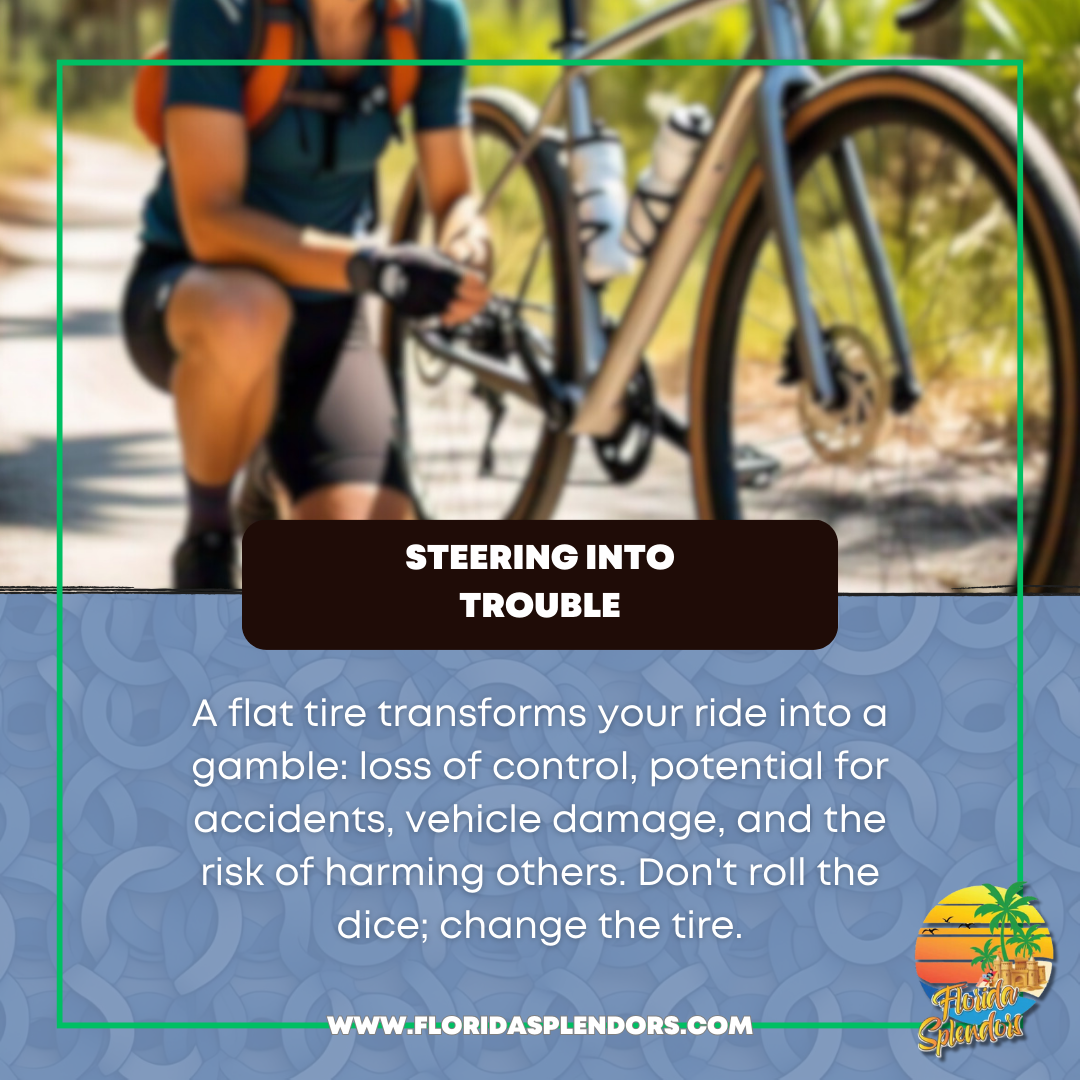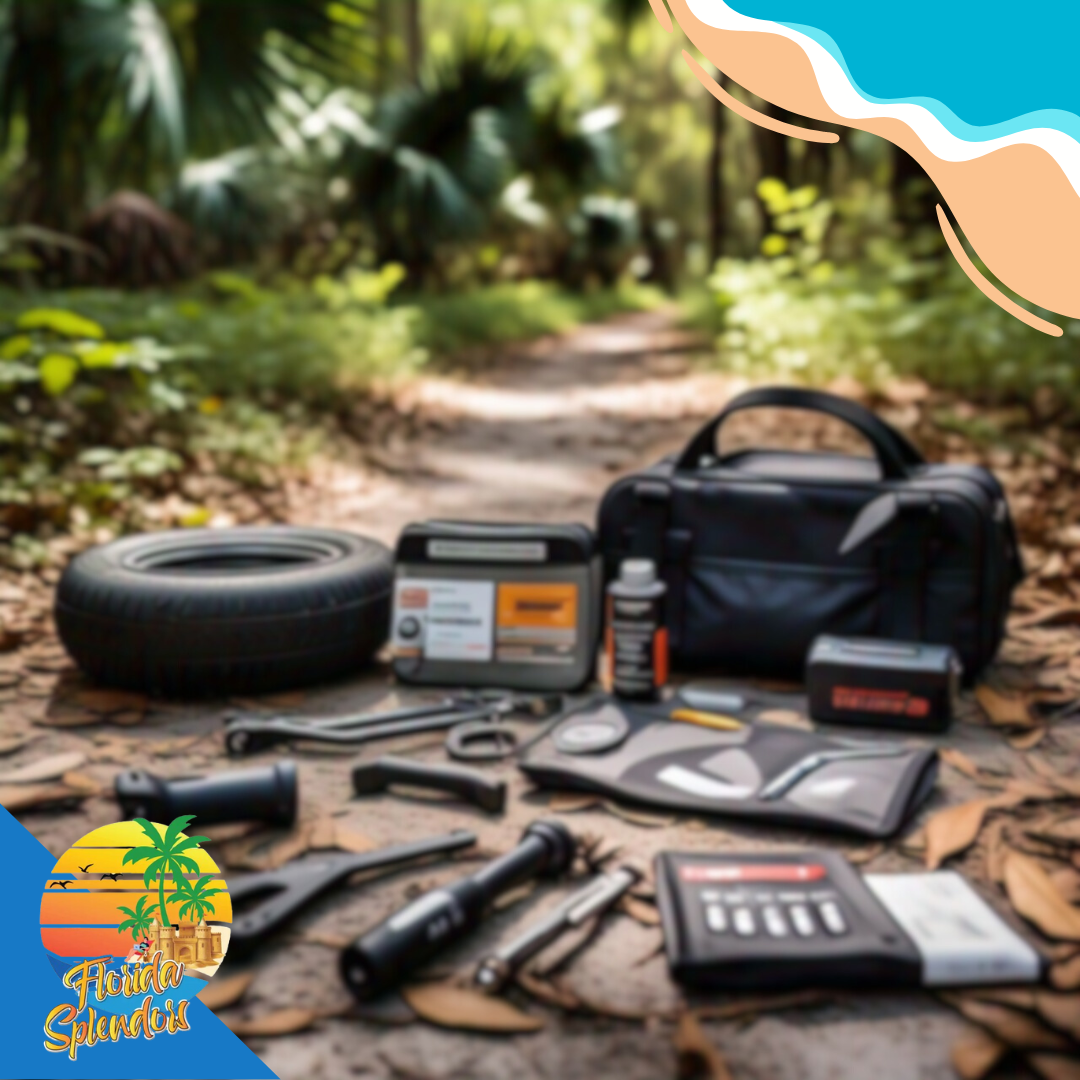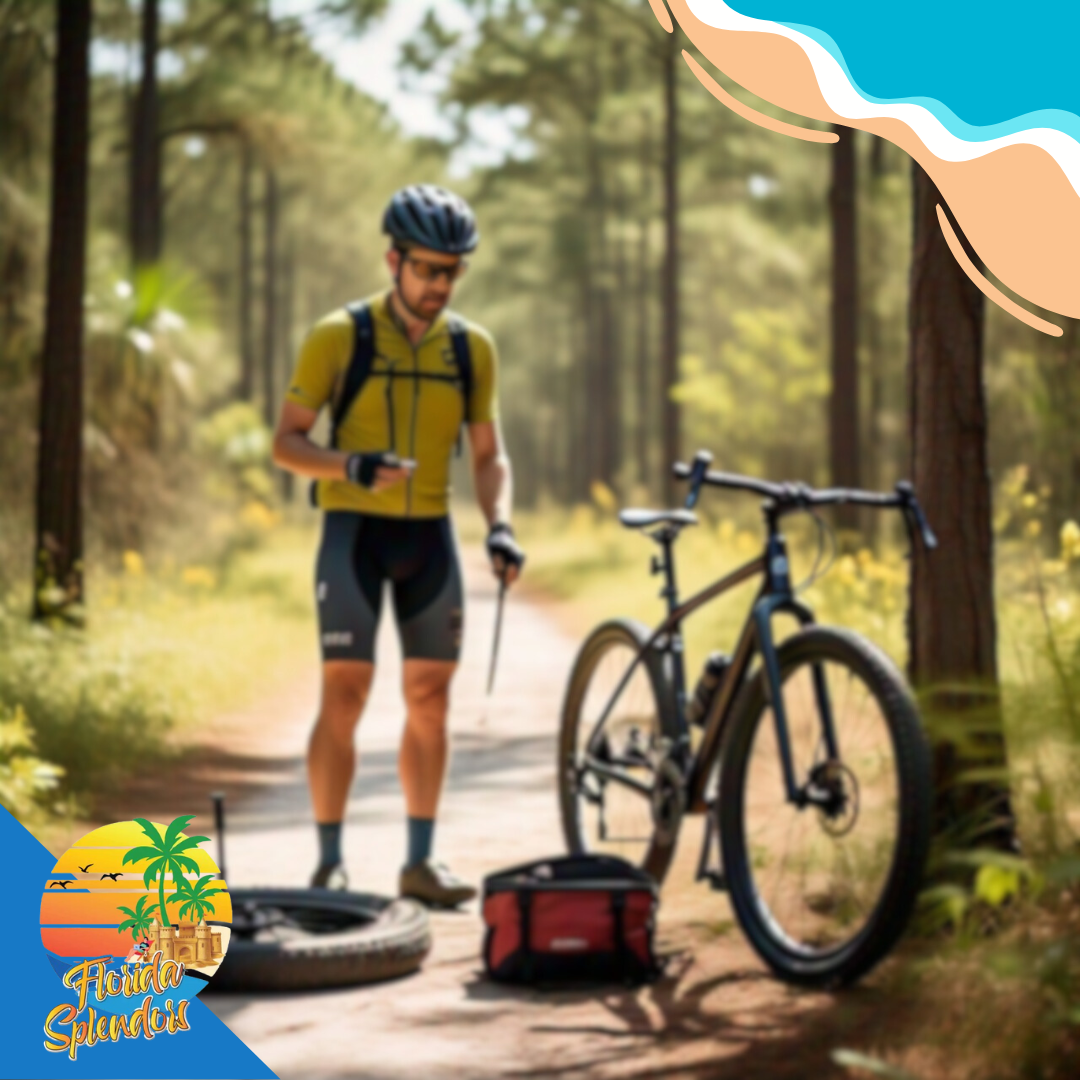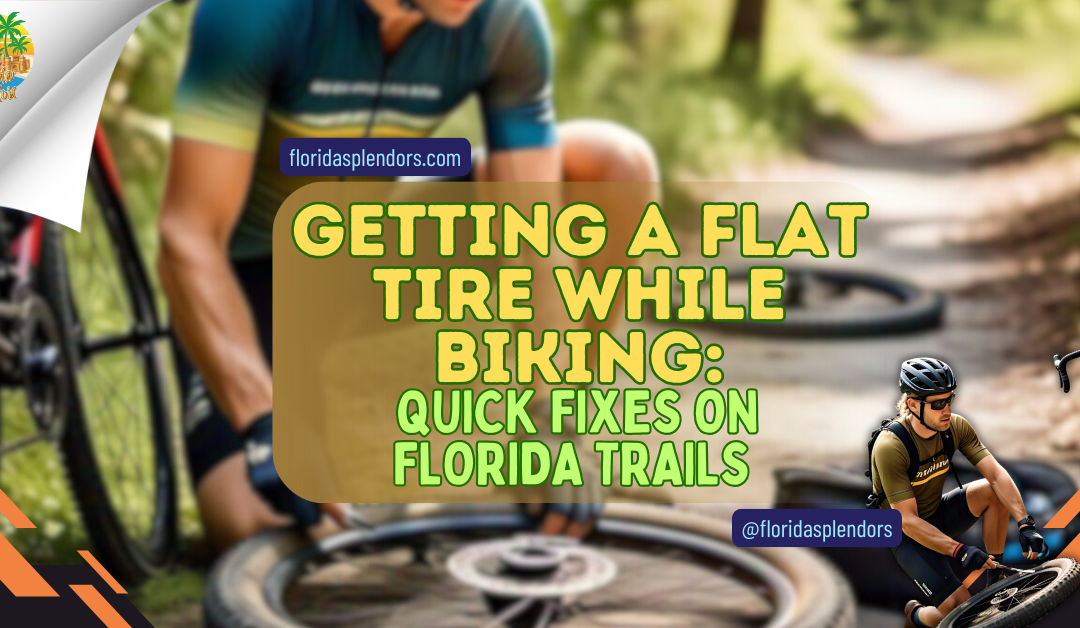==================
Florida Splendors is supported by our audience. When you purchase through one of our links, we may earn a small affiliate commission. As an Amazon Associate I earn from qualifying purchases. Your cost is not affected.
Getting a flat tire while biking is one of those unfortunate events that can happen to anyone, no matter how prepared we are. While we take all the right measures to prevent accidents, mishaps still occur, and I’ve experienced it myself, as have those close to me. A flat tire might seem like a common setback, but it’s worth discussing because it can quickly derail an otherwise enjoyable ride, especially when you’re out on a trail. Knowing how to handle it ensures that you’re not stuck for long, and being prepared helps you avoid unnecessary stress. It’s all about keeping your adventure going, even when the unexpected happens.
Getting a Flat Tire While Biking on Florida Trails: Quick Fixes and Tips
Getting a flat tire while biking on a Florida trail can be frustrating, but it’s not the end of your adventure. Many cyclists face this problem, and with the right knowledge and tools, you can quickly get back on track.
If your bike tire goes flat on a Florida trail, you can fix it by removing the wheel, checking for punctures, patching or replacing the tube, and reinflating the tire.

Being prepared is key when cycling on trails. Carry a repair kit with spare tubes, patches, and a pump. This way, you’re ready to handle any tire issues that come up.
Florida trails can have thorns, sharp rocks, or other objects that might cause a flat, so it’s smart to be ready.

Key Takeaways
- Carry a bike repair kit with tubes, patches, and a pump on Florida trails
- Check your tires regularly and remove any sharp objects to prevent flats
- Learn basic tire repair skills to fix flats quickly and safely on the trail

Understanding Bike Tires and Pressure

Bike tires and pressure play a crucial role in your cycling experience. Choosing the right tires and maintaining proper pressure can make a big difference in your ride comfort and safety.
Types of Bike Tires and Their Uses
Mountain bike tires are wide and have knobby treads. They give you great traction on rough trails. Road bike tires are narrow and smooth. These help you go fast on paved roads.
Hybrid tires fall in between. They work well for both city streets and light trails. Gravel bike tires are a bit wider than road tires. They handle both pavement and unpaved roads.
For Florida trails, consider wider tires with some tread. They’ll give you better grip on sandy or muddy paths.
How to Check Your Tire Pressure
Checking your bike tire pressure is easy. You’ll need a tire pressure gauge.
Remove the valve cap from your tire. Press the gauge onto the valve stem. The gauge will show you the PSI (pounds per square inch).
Most bike tires need between 30 and 100 PSI. Mountain bikes use lower pressures, around 30-50 PSI. Road bikes need higher pressures, often 80-100 PSI.
Check your tire’s sidewall for the recommended PSI range. Adjust your pressure based on your weight and riding conditions. Softer tires give more comfort, while harder tires roll faster.
Check your tire pressure before every ride. This helps prevent flat tires and ensures a smooth, safe journey on Florida trails.
Pre-Trail Preparation

Getting ready for a Florida bike trail ride means having the right gear and tools. A little planning can make a big difference if you run into trouble.
Selecting the Right Gear for Florida Trails
Choose the right tires for Florida’s varied terrain. Road tires work well on paved trails, but consider wider, knobby tires for dirt paths. Tubeless tires can be a good option to reduce the risk of flats.
Pack plenty of water and snacks. Florida’s heat can be intense, so stay hydrated.
Wear breathable, light-colored clothing to stay cool. Don’t forget sunscreen and bug spray.
A basic tool kit is essential. Include a multi-tool for quick adjustments on the go.
Packing a Repair Kit
Your repair kit is your lifeline if you get a flat. Here’s what to include:
- Spare tube (make sure it’s the right size)
- Patch kit for quick fixes
- Tire levers to remove the tire
- Portable pump or CO2 inflator
- Small first-aid kit
Learn how to use your tools before you hit the trail. Practice changing a tube at home. This will save you time and stress if you get a flat on the trail.
Consider bringing some cash and a phone. You might need to call for help or buy supplies.

What's Inside
- Explore 1,500 Miles of Florida's Scenic Biking Trails
- What should I pack in my repair kit for a flat bike tire on a trail?
- How can I prevent my bike tires from going flat frequently?
- What's the best way to fix a flat bike tire without a patch kit?
- Can riding style or terrain choice affect the frequency of flat tires?
- What steps should I take immediately after getting a bike tire flat on a trail?
- How do you locate a puncture when the bike tire is flat but has no visible hole?
Explore 1,500 Miles of Florida's Scenic Biking Trails
Florida is home to over 1,500 miles of biking trails, including scenic routes through forests, wetlands, and along beaches, making it one of the top cycling destinations in the U.S.!
Identifying Common Tire Problems

Bike tires can face several issues on Florida trails. Knowing how to spot these problems early can save you from a frustrating ride. Let’s look at some common tire troubles you might encounter.
Recognizing Early Signs of a Flat Tire
Keep an eye out for signs of a flat tire while riding. You might feel your bike handling differently or hear a thumping sound.
Check your tires often for:
- Slow leaks: Your tire loses air gradually
- Punctures: Small objects stuck in the tire
- Pinhole leaks: Tiny holes hard to spot
If you notice your bike feeling sluggish, stop and inspect your tires. Press them to check for proper inflation. A soft tire needs attention right away.
Pinch Flats and How to Avoid Them
Pinch flats happen when you hit something hard, like a rock or root. Your tire gets “pinched” between the obstacle and your rim. To avoid these:
- Keep your tires properly inflated
- Use wider tires if possible
- Lift your weight off the saddle when riding over bumps
Low tire pressure makes pinch flats more likely. Check your pressure before hitting the trails. If you’re lighter, you can run slightly lower pressures for better grip.
Damages on the Tire Sidewall
Your tire’s sidewall can get damaged on rough trails. Look for:
- Cuts or gashes in the rubber
- Bulges or deformities
- Fraying or exposed threads
These issues can lead to blowouts if not addressed.
Inspect your sidewalls after riding through thorny areas or rocky sections. Small cuts might be fine, but larger damages need immediate attention.
Replace your tires if you see significant sidewall wear. It’s better to be safe than sorry on the trail.
Step-by-Step Repairing a Flat Bike Tire

Fixing a flat tire on your bike is a useful skill to have, especially when riding Florida trails. You’ll need a few basic tools and some patience. Let’s go through the process step-by-step.
Removing the Wheel and the Damaged Tire
First, you’ll need to take off the affected wheel. For a rear tire, shift to the smallest gear to make removal easier. Release the brake if needed. Open the quick-release lever or use a wrench to loosen the axle nuts.
Carefully remove the wheel from the bike frame.
Now, let’s get that tire off. Use tire levers to pry one side of the tire off the rim. Work your way around until one side is completely free.
You can then pull out the inner tube. Be gentle to avoid damaging the valve stem. If you’re dealing with a rear tire, take care not to tangle the tube in the gears.
Inspecting the Tire and Removing Debris
Take a close look at your tire. Run your fingers along the inside, feeling for any sharp objects that might have caused the flat. Be careful not to cut yourself!
If you find something, remove it carefully. Small pieces of glass or thorns can be tricky to spot. A flashlight can help you see better.
Check the outside of the tire too. Look for cuts or worn spots that might let foreign objects in. If the tire is badly damaged, you might need to replace it entirely.
Don’t forget to inspect the rim tape. It should cover all spoke holes to protect the tube from sharp edges.

Applying a Patch or Replacing the Inner Tube
Now you need to decide: patch or replace?
If you can find a small puncture, patching can work well. Clean the area around the hole and roughen it slightly. Apply the patch according to its instructions.
If the hole is large or you can’t find it, it’s best to use a new tube. Make sure it’s the right size for your tire.
Slightly inflate the new tube to give it shape.
Put a little air in the tube and listen for any hissing. This can help you find leaks. If all seems good, you’re ready to put everything back together.
Reassembling Your Bike Tire
Start by placing the tube back inside the tire. Be careful not to twist it. Make sure the valve stem is straight and properly positioned in the rim’s valve hole.
Begin working one side of the tire back onto the rim. Use your hands for this if possible. If you need tire levers, be careful not to pinch the tube.
Once the tire is on, check that the tube isn’t trapped between the tire and rim.
Fully inflate the tire to the proper pressure. Put the wheel back on your bike, making sure it’s secure. Test the brakes before you ride off. You’re now ready to hit the Florida trails again!
Protecting Your Tires in the Long Term

Keeping your bike tires in good shape can help you avoid flats on Florida trails. Taking care of your tires involves using protective gear and doing regular maintenance.
Using Tire Liners and Other Protective Gear
Tire liners are a great way to add an extra layer of protection to your tires. They fit between the tire and tube, helping to prevent punctures from thorns or sharp objects.
You can also use rim tape to protect your inner tube from spoke holes. Velox rim tape is a popular choice among cyclists.
When installing tire liners or rim tape, make sure they’re properly aligned. This will help prevent rim damage and deformation.
For extra protection on rough trails, consider tubeless tires. They’re less prone to punctures and can be a good long-term investment.

Routine Maintenance Tips
Check your tire pressure regularly. Low pressure can lead to more flats and damage to your rims.
Inspect your tires before each ride. Look for any cuts, embedded objects, or signs of wear.
Clean your tires after muddy rides. This helps you spot any damage and keeps your tires in good condition.
Replace your tires when the tread is worn. Old, thin tires are more likely to get flats.
Store your bike in a cool, dry place when not in use. Heat and sunlight can damage rubber over time.
Getting a Flat Tire While Biking: The End of Our Ride
Accidents, no matter how prepared we are, are bound to happen. While we can’t completely prevent mishaps like getting a flat tire while biking, it’s always best to be prepared when they do occur. Even the most common issues, such as a flat tire on the road or trail, are worth discussing every so often because being ready can save you time and frustration.

Here, we’ve covered everything from tire types to pressure checks, packing a repair kit, and the steps to fix a flat. We also talked about the importance of regular tire maintenance and the tools you’ll need to get back on the trail.
Now that you’re equipped with the knowledge, I hope you’re ready for your next adventure. Stay safe, keep your tires in check, and happy biking!
Frequently Asked Questions

Dealing with flat bike tires on Florida trails requires preparation and know-how. These questions cover essential tips for handling flats and keeping your tires in good shape.
What should I pack in my repair kit for a flat bike tire on a trail?
Pack a spare tube, tire levers, and a compact pump or CO2 inflator. Include a multi-tool with Allen wrenches for removing wheels. Carry tire patches for temporary fixes.
Don’t forget some cash and a phone in case you need to call for help.
How can I prevent my bike tires from going flat frequently?
Check your tire pressure before each ride. Use tires suited for Florida’s terrain.
Remove small objects stuck in your tires after rides. Inspect your tires regularly for wear and replace them when needed.
What's the best way to fix a flat bike tire without a patch kit?
Use natural materials like leaves or grass to stuff inside the tire as a temporary fix. This can help you ride slowly to a safe spot.
If you have duct tape, wrap it around the tube to cover small holes.
Can riding style or terrain choice affect the frequency of flat tires?
Yes, aggressive riding can lead to more flats. Avoid sharp turns and hard braking.
Choose smoother paths when possible. Florida trails with fewer roots and rocks are kinder to your tires.
What steps should I take immediately after getting a bike tire flat on a trail?
Stop riding to avoid damaging your wheel. Move to a safe spot off the trail.
Check your surroundings and let someone know your location. Then, start your repair process or call for assistance.
How do you locate a puncture when the bike tire is flat but has no visible hole?
Inflate the tube and listen for escaping air. Then, run your hand around the tube to feel for air.
Submerge the inflated tube in water and look for bubbles. Mark the spot when you find it.
Explore Florida Trails with Us!
Join us for more biking tips and trail adventures on our social media. Stay updated with engaging content, product reviews, and community connections:
| Platform | Link |
|---|---|
| FloridaSplendors | |
| @floridasplendors | |
| floridasplendors | |
| X | FloridaSplendor |
Connect, explore, and experience Florida like never before!

